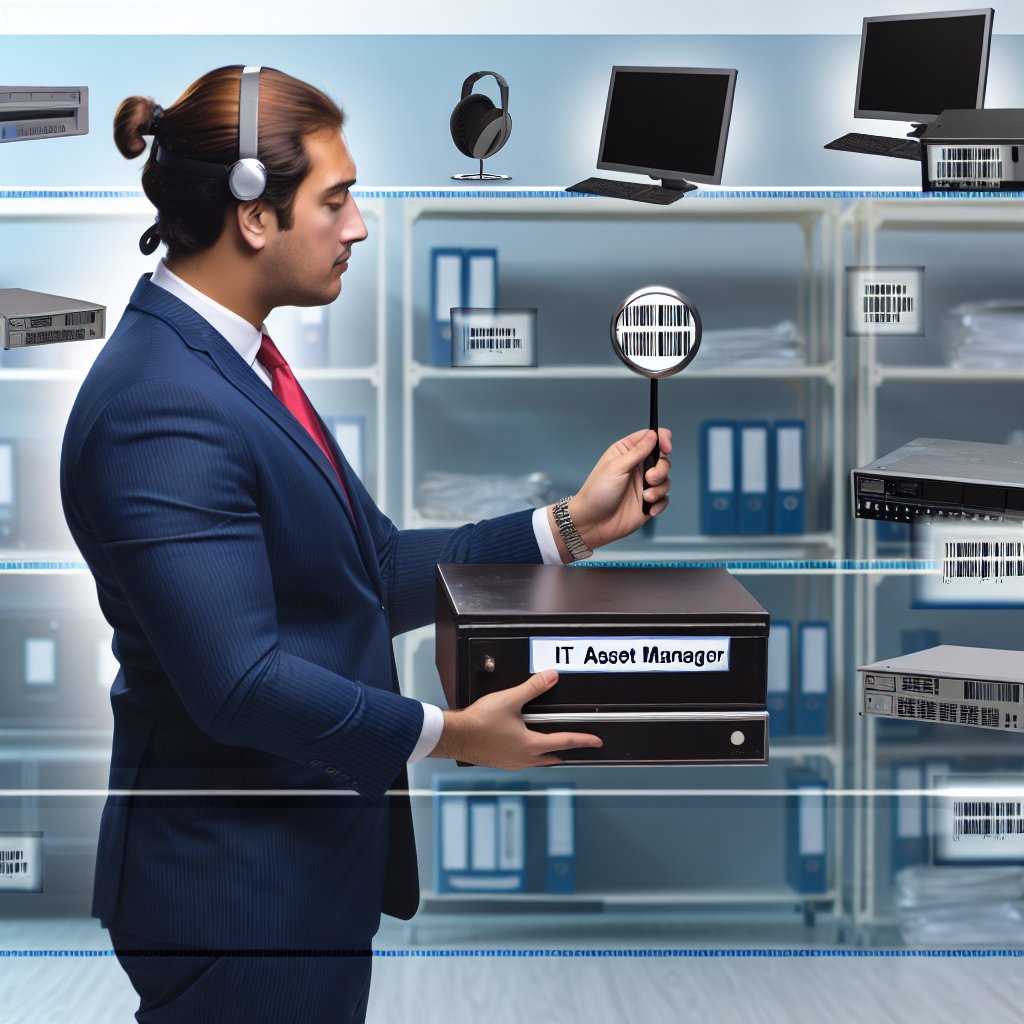Introduction:
IT asset management is crucial for small to medium businesses to effectively track and manage their technology resources.
Importance of IT Asset Management for Small to Medium Businesses
IT asset management is crucial for small to medium businesses to effectively track and manage their technology resources.
Definition and Benefits of IT Asset Management
IT asset management involves tracking and optimizing the usage of IT assets to maximize value and minimize risks.
Proper IT asset management can lead to cost savings, improved productivity, and enhanced decision-making.
Improving Operational Efficiency and Reducing Costs
Effective IT asset management can streamline processes, avoid unnecessary expenses, and ensure compliance with regulations.
By optimizing asset usage and lifecycle management, businesses can make better strategic decisions and drive growth.
Assessing IT Assets:
Assessing IT assets is a critical first step in IT asset management for small to medium businesses.
By identifying and documenting all IT assets, businesses can gain a comprehensive understanding of what they have and how these assets contribute to their operations.
When identifying IT assets, businesses need to look beyond just hardware.
Software licenses, subscriptions, and digital assets such as domain names and intellectual property should also be included in the audit process.
This ensures that no asset is overlooked and that the full scope of the business’s IT resources is captured.
Conducting a thorough audit is essential to create a baseline inventory of all IT assets.
This includes details such as the make, model, serial number, and location of hardware assets, as well as the version, license key, and vendor information of software assets.
Digital assets should be categorized and valuated based on their importance to the business.
By determining the current state of each asset, businesses can assess their usability, performance, and potential risks.
Assets that are outdated, underutilized, or in need of maintenance can be flagged for attention.
Understanding the value of each asset to the business helps in prioritizing resources and investments for optimal IT asset management.
Assessing IT assets involves a comprehensive evaluation of all hardware, software, and digital assets within a business.
This process provides businesses with valuable insights into their IT infrastructure and helps in making informed decisions regarding asset management.
- Identify all IT assets within the business.
- Conduct a thorough audit to document all hardware, software, and digital assets.
- Determine the current state of each asset and its value to the business.
Creating an Asset Inventory:
Develop a comprehensive asset inventory database.
Transform Your Career Today
Unlock a personalized career strategy that drives real results. Get tailored advice and a roadmap designed just for you.
Start NowInclude details such as purchase date, purchase cost, warranty information, and usage history.
Regularly update the inventory to track changes and new acquisitions.
Why is Asset Inventory Important for Small to Medium Businesses?
Having a clear and up-to-date asset inventory is crucial for small to medium businesses.
It allows companies to keep track of all their IT assets, understand their value, and monitor their usage.
This information is essential for making informed decisions regarding asset management, budgeting, and future investments.
Developing a Comprehensive Asset Inventory Database
To create an effective asset inventory, businesses need to develop a comprehensive database that includes all relevant information about each asset.
This database should capture details such as the purchase date, purchase cost, warranty information, and usage history.
Including Important Details in the Asset Inventory
Including key details in the asset inventory helps businesses understand the lifecycle of their IT assets.
Purchase date and cost provide insights into the financial investment in each asset.
Warranty information ensures that businesses can track the warranty period and plan for repairs or replacements if needed.
Usage history gives a clear picture of how each asset has been utilized over time.
Regularly Updating the Inventory
It is essential for businesses to regularly update their asset inventory to reflect changes in the IT environment.
New acquisitions should be promptly added to the database, and any changes in the status of existing assets should be recorded.
This ensures that the inventory remains accurate and up-to-date, enabling businesses to make well-informed decisions.
Utilizing Asset Inventory for Effective Management
By maintaining an accurate and comprehensive asset inventory, small to medium businesses can effectively manage their IT assets.
This information can be used to identify underutilized assets, plan for upgrades or replacements, and optimize asset allocation.
It also helps businesses stay compliant with licensing agreements and regulatory requirements.
Benefits of Maintaining an Asset Inventory
There are several benefits to maintaining an asset inventory for small to medium businesses.
It enables better asset management practices, helps in budgeting and forecasting, enhances security by tracking all IT assets, and streamlines compliance efforts.
Showcase Your Business Today
Reach thousands of readers actively exploring professional services. Publish your business profile and grow your audience now.
Publish NowUltimately, a well-maintained asset inventory is a valuable tool for improving operational efficiency and driving business growth.
Maximizing IT Investments for Operational Efficiency
Creating and maintaining an asset inventory is a critical aspect of IT asset management for small to medium businesses.
By developing a comprehensive database, including important details, and regularly updating the inventory, businesses can make informed decisions, optimize asset management practices, and drive growth.
It is an essential tool for maximizing the value of IT investments and ensuring operational efficiency.
Discover More: Best Tools and Software for Virtualization Engineers
Implementing Asset Tracking System:
Utilize asset tracking software to monitor the location and status of each asset.
This software can help you keep track of all your IT assets in one centralized system.
You can easily see where each asset is located, who is using it, and its maintenance history.
By having real-time visibility into your assets, you can improve efficiency and reduce loss.
Assign unique identifiers to assets for easy tracking and identification.
Each asset should have a unique code or number that allows you to easily identify it.
This can prevent confusion and ensure that each asset is accounted for.
Implement barcode or RFID technology for efficient asset tracking.
Barcodes or RFID tags can be scanned quickly to update the asset’s status.
This technology can streamline the tracking process and reduce human error.
You can also integrate barcode or RFID scanners with your asset tracking software.
Utilizing Asset Management Tools:
Consider using asset management tools to automate processes and streamline operations.
These tools can help you track warranties, licenses, and maintenance schedules for each asset.
You can set up alerts for upcoming renewals or maintenance tasks to avoid any disruptions.
Asset management tools can also provide insights into asset utilization and performance.
Make sure to invest in a user-friendly tool that meets the specific needs of your business.
Evaluate different options and choose the one that aligns with your budget and goals.
Training your team on how to use the asset management tool effectively is crucial.
Provide ongoing support and guidance to ensure that the system is being utilized to its full potential.
Establishing Asset Management Policies:
Develop clear asset management policies to establish guidelines and procedures.
Define who is responsible for managing assets, updating records, and performing audits.
Specify how assets should be acquired, tracked, and disposed of in compliance with regulations.
Implement security measures to protect sensitive data stored on IT assets.
Regularly review and update asset management policies to reflect changes in the business.
Conduct periodic audits to ensure that all assets are accounted for and in good condition.
Enforce consequences for non-compliance with asset management policies to foster accountability.
Communicate the importance of asset management to all employees and stakeholders.
Enhancing IT Asset Efficiency:
Implementing an asset tracking system is essential for small to medium businesses.
Utilize asset tracking software, assign unique identifiers, and implement barcode or RFID technology.
Incorporate asset management tools, establish clear policies, and provide training to your team.
By effectively managing your IT assets, you can improve efficiency, reduce costs, and mitigate risks.
Remember that asset management is an ongoing process that requires dedication and attention to detail.
See Related Content: Strategies for Effective Network Troubleshooting
Establishing Maintenance Procedures:
Maintaining IT assets is crucial for the smooth operation of small to medium businesses.
By establishing proper maintenance procedures, companies can ensure that their IT systems are running efficiently and securely.
Showcase Your Business Today
Reach thousands of readers actively exploring professional services. Publish your business profile and grow your audience now.
Publish NowHere are some key steps to consider when developing maintenance schedules for IT assets:
Developing maintenance schedules:
To start, it is essential to create a detailed maintenance schedule for each IT asset in your organization.
This schedule should outline regular maintenance tasks, such as software updates, hardware checks, and system optimizations.
By following a structured maintenance plan, businesses can proactively address potential issues before they escalate.
Conducting regular updates, patches, and upgrades:
One of the most critical maintenance tasks for IT assets is staying up to date with software updates, patches, and upgrades.
These updates are essential for addressing security vulnerabilities, improving performance, and adding new features to IT systems.
By regularly applying updates, businesses can enhance the overall functionality and security of their IT assets.
Implementing a system for monitoring asset lifespan:
In addition to regular maintenance tasks, it is essential to monitor the lifespan of IT assets and plan for replacements accordingly.
By tracking the age and performance of each asset, businesses can anticipate when equipment may need to be upgraded or replaced.
This proactive approach can help prevent unexpected downtime and ensure that IT systems continue to meet the needs of the business.
Planning for replacements:
As IT assets age and technology evolves, it is crucial to have a plan in place for replacing outdated or malfunctioning equipment.
This may involve budgeting for new purchases, researching the latest technology trends, and working with vendors to find the best solutions for the business.
By planning ahead for replacements, companies can avoid sudden expenses and disruptions to their IT infrastructure.
Establishing maintenance procedures for IT assets is essential for the long-term success of small to medium businesses.
By developing maintenance schedules, conducting regular updates, monitoring asset lifespan, and planning for replacements, companies can ensure that their IT systems remain reliable, secure, and efficient.
With a proactive approach to maintenance, businesses can optimize their IT investments and support their overall growth and success.
Gain More Insights: Tech Evangelist’s Role in Enhancing User Experience

Security and Compliance:
Implement security measures to protect IT assets from cyber threats and data breaches.
Ensure compliance with industry regulations and data protection laws.
Train employees on best practices for IT security and asset management.
Implementing Security Measures:
In today’s digital age, protecting IT assets from cyber threats is crucial for the success of small to medium businesses.
Implementing robust security measures helps safeguard sensitive data and prevent unauthorized access.
One effective security measure is to install firewalls and antivirus software to detect and block malicious attacks.
Regularly updating software and operating systems also helps patch vulnerabilities that cybercriminals may exploit.
Additionally, implementing multi-factor authentication adds an extra layer of security by requiring users to provide multiple forms of verification before accessing sensitive information.
Ensuring Compliance:
Compliance with industry regulations and data protection laws is essential to avoid legal repercussions and maintain trust with customers.
Small to medium businesses must stay informed about the latest compliance requirements and ensure that their IT asset management practices align with these standards.
Regular audits and assessments can help businesses identify areas where they may be falling short of compliance requirements and take corrective actions promptly.
This proactive approach reduces the risk of penalties and reputational damage.
Training Employees:
Employee training is a critical component of maintaining IT security and proper asset management.
Employees should be educated on best practices for protecting IT assets, such as creating strong passwords, recognizing phishing attempts, and securely storing confidential data.
Regular training sessions and workshops can help reinforce these practices and ensure that employees remain vigilant against potential security threats.
By investing in employee education, businesses can build a culture of security awareness that permeates throughout the organization.
See Related Content: Job Outlook for Telecommunications Specialists in the US
Budgeting and Cost Control:
Create a budget for IT asset management activities.
This includes maintenance, upgrades, and replacements.
Implement cost-saving strategies such as asset reuse, virtualization, and vendor negotiations.
Monitor expenses and track ROI on IT asset investments.
When managing IT assets for small to medium businesses, budgeting and cost control play a crucial role. They ensure the efficient use of resources while maximizing returns.
It is important to create a comprehensive budget that covers all aspects of IT asset management activities.
Showcase Your Business Today
Reach thousands of readers actively exploring professional services. Publish your business profile and grow your audience now.
Publish NowBy having a clear budget in place, businesses can allocate funds strategically and avoid overspending.
Furthermore, implementing cost-saving strategies is essential for small to medium businesses.
These strategies help optimize their IT asset management processes.
One effective strategy is asset reuse. This involves repurposing existing assets for different projects or departments.
By doing so, businesses can reduce unnecessary expenditures and extend the life cycle of IT assets.
Virtualization is another cost-saving technique that businesses can leverage.
By virtualizing servers, storage, and networking resources, companies can reduce hardware costs.
This process increases operational efficiency and improves scalability.
Additionally, virtualization enhances disaster recovery capabilities and simplifies IT management.
Vendor negotiations are also a key aspect of cost control in IT asset management.
By negotiating favorable terms with vendors, businesses can secure better prices, discounts, or service agreements.
This can result in significant cost savings and better value for money.
Ultimately, it helps businesses stay within their budget constraints.
Monitoring expenses and tracking return on investment (ROI) on IT asset investments is critical.
These measures evaluate the effectiveness of budgeting and cost control measures.
By analyzing the costs associated with IT asset management activities, businesses can identify areas for improvement.
This data-driven approach helps businesses optimize their IT asset management strategies.
Ultimately, it helps them achieve long-term cost savings.
Importance of IT Asset Management for SMBs
Effective IT asset management is essential for small to medium businesses.
It ensures optimal utilization of resources and reduces costs.
Moreover, it mitigates risks associated with IT assets.
By maintaining an accurate inventory, businesses can track software licenses.
They can also monitor warranties and upgrades more efficiently.
Proper IT asset management enhances security measures significantly.
It helps to identify vulnerabilities and ensures timely updates and patches.
Prioritizing IT asset management helps SMBs maximize productivity.
This strategy enables businesses to stay competitive in the market.
Therefore, investing in robust IT asset management tools is crucial.
These tools streamline operations and drive growth.
Managing IT assets effectively is not just a cost-saving measure.
It’s a strategic approach to achieving long-term success.
Do not overlook the importance of IT asset management for your business.
It could be the key to unlocking your full potential.
Additional Resources
Churchill Asset Management | Leading Private Capital Manager
“Asset Management Operations and Controls,” Comptroller’s …
[E-Books for Sale]
The Big Book of 500 High-Paying Jobs in America: Unlock Your Earning Potential
$19.99 • 500 High-Paying Jobs • 330 pages
Explore 500 high-paying jobs in America and learn how to boost your career, earn more, and achieve success!
See All 500 High-Paying Jobs of this E-Book
1001 Professions Without a Degree: High-Paying American Jobs You Can Start Now
$19.99 • 1001 Professions Without a Degree • 174 pages
Discover 1001 high-paying jobs without a degree! Unlock career tips, skills, and success strategies for just $19.99!




